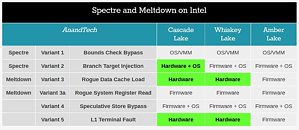- Joined
- Oct 9, 2007
- Messages
- 47,294 (7.52/day)
- Location
- Hyderabad, India
| System Name | RBMK-1000 |
|---|---|
| Processor | AMD Ryzen 7 5700G |
| Motherboard | ASUS ROG Strix B450-E Gaming |
| Cooling | DeepCool Gammax L240 V2 |
| Memory | 2x 8GB G.Skill Sniper X |
| Video Card(s) | Palit GeForce RTX 2080 SUPER GameRock |
| Storage | Western Digital Black NVMe 512GB |
| Display(s) | BenQ 1440p 60 Hz 27-inch |
| Case | Corsair Carbide 100R |
| Audio Device(s) | ASUS SupremeFX S1220A |
| Power Supply | Cooler Master MWE Gold 650W |
| Mouse | ASUS ROG Strix Impact |
| Keyboard | Gamdias Hermes E2 |
| Software | Windows 11 Pro |
Intel "Whiskey Lake" CPU microarchitecture recently made its debut with "Whiskey Lake-U," an SoC designed for Ultrabooks and 2-in-1 laptops. Since it's the 4th refinement of Intel's 2015 "Skylake" architecture, we wondered what set a "Whiskey Lake" core apart from "Coffee Lake." Silicon fabrication node seemed like the first place to start, with rumors of a "14 nm+++" node for this architecture, which should help it feed up to 8 cores better in a compact LGA115x MSDT environment. Turns out, the process hasn't changed, and that "Whiskey Lake" is being built on the same 14 nm++ node as "Coffee Lake."
In a statement to AnandTech, Intel explained that the key difference between "Whiskey Lake" and "Coffee Lake" is silicon-level hardening against "Meltdown" variants 3 and 5. This isn't just a software-level mitigation part of the microcode, but a hardware fix that reduces the performance impact of the mitigation, compared to a software fix implemented via patched microcode. "Cascade Lake" will pack the most important hardware-level fixes, including "Spectre" variant 2 (aka branch target injection). Software-level fixes reduce performance by 3-10 percent, but a hardware-level fix is expected to impact performance "a lot less."

View at TechPowerUp Main Site
In a statement to AnandTech, Intel explained that the key difference between "Whiskey Lake" and "Coffee Lake" is silicon-level hardening against "Meltdown" variants 3 and 5. This isn't just a software-level mitigation part of the microcode, but a hardware fix that reduces the performance impact of the mitigation, compared to a software fix implemented via patched microcode. "Cascade Lake" will pack the most important hardware-level fixes, including "Spectre" variant 2 (aka branch target injection). Software-level fixes reduce performance by 3-10 percent, but a hardware-level fix is expected to impact performance "a lot less."

View at TechPowerUp Main Site




 )
)

